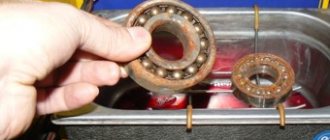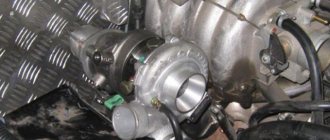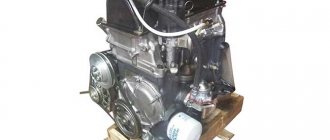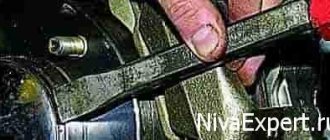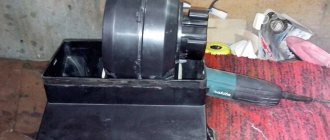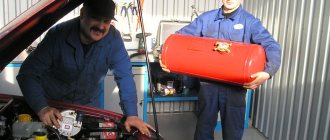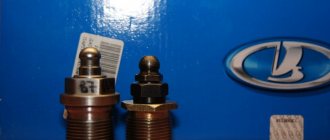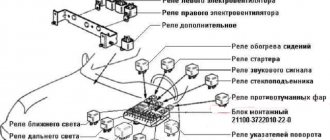Fuel tank capacity NIVA Chevrolet
Many car enthusiasts claim that the domestic automobile industry is in complete ruin and there are no worthy companies producing normal cars.
However, this is a complete misconception and our engineers, albeit infrequently, can produce products worthy of attention.
One of these is the NIVA Chevrolet all-wheel drive SUV from the VAZ automobile plant, which is in mass production.
Available modifications
In 2006, AvtoVAZ launched into mass production a new generation of NIVA Chevrolet, which used a more powerful power unit from Opel, in tandem with which the engineers decided to install a five-speed transfer-type manual transmission. This combination made it possible to significantly increase the power and dynamic characteristics of the SUV.
The electronic equipment of the car has also undergone significant changes. The vehicle has become more modern, comfortable and safe. The brake system is equipped with an anti-lock braking system, and the discs are equipped with ten-inch vacuum brake boosters.
To increase the reliability of protection and safety of life of the driver and front passenger, the developers equipped the SUV with two modern airbags. An active air conditioning system has been installed in the car interior, providing an optimal interior microclimate.
The SUV leaves the assembly line in a two-volume body, the characteristic feature of which is a slightly reduced interior space in favor of the luggage compartment. To increase the efficiency of using usable space, the fuel tank was located under the bottom of the car, and was also made in a form with a very complex design, which has a certain impact on the gasoline supply.
Gas tank characteristics
According to the technical data sheet of the car, the SUV is equipped with a gas tank designed for 58 liters of fuel, and if the supply of fuel decreases, the system will notify the driver using a special indicator located next to the dashboard.
However, it should be noted that due to the design of the fuel tank and its complex shape, a dead reserve of gasoline of about 7 liters is formed in it. When the light flashes, indicating the need to replenish the fuel supply. This usually happens when there are about 10 liters of gasoline left in the tank.
When refueling, the driver can add about 44 liters, which leads to the conclusion that the actual volume of the gas tank is more than 60 liters. However, it is also necessary to understand the fact that it is impossible to give an unambiguous answer to the question about the volume of the fuel tank due to certain explainable reasons.
Firstly, the gas tank sensor is an old model, so it is unable to show the real amount of fuel, and secondly, in the warm and cold months of the year, different amounts of gasoline are placed in the gas tank.
Refill tanks Niva Chevrolet
Appendix 4. Chevrolet Niva refueling volumes
- Repair manuals
- Repair manual for Chevrolet Niva 2002+.
- Appendix 4. Filling volumes
Tank volume Hyundai Solaris
2x h16
| Fuel tank | 58,0 |
| Engine cooling system | 8,0 |
| Engine lubrication system | 3,75 |
| Gearbox housing | 1,6 |
| Transfer case housing | 0,79 |
| Front axle housing | 1,15 |
| Rear axle housing | 1.3 |
| Hydraulic brake system | 0,5 |
| Hydraulic shutdown system | 0,15 |
| clutch | |
| Windshield washer reservoir | 5,0 |
| Tailgate glass washer reservoir | 2,0 |
| Front shock absorber | 0,15 |
| Rear shock absorber | 0,215 |
| Power steering | 1,7 |
Repairing auto parts yourself is a responsible task that should be taken as seriously as possible. Sometimes a faulty spare part takes the driver by surprise, forcing him to spend a lot of time and money searching for a good service station, but there is an alternative solution to the problem; this requires a small amount of knowledge and a set of tools.
When repairing Appendix 4. Chevrolet Niva filling volumes, you need to be extremely careful and not neglect the little things. To get acquainted with the issue, car enthusiasts often use various Internet portals dedicated to auto parts. Some of them use narrowly focused forums.
But, as a rule, only generalized information is provided there, which is known initially. Where can you find a reliable source that offers really useful things? Our portal is open for this 24 hours a day. Online mode allows us to help clients at any time convenient for them.
Moreover, a mobile version has been developed that is available to everyone.
A detailed description of such a unit as Appendix 4. Chevrolet Niva filling volumes has a good structure with thematic headings. In addition, there is always the opportunity to familiarize yourself with the intricacies of installation.
There are often situations when a driver is confident in his abilities, but when he gets down to work, questions begin to arise. Thanks to our portal, such moments can be easily avoided. The site is a database that is updated regularly.
By using it as a support during repair work, the car enthusiast receives a serious advantage. Each of the articles has reliable support, tested in practice.
In addition to the repair manual, the owner of a personal car will be able to prevent a lot of breakdowns that occur due to the human factor, thanks to the information located on the site. Users are presented with a lot of useful recommendations for proper operation, which will help significantly extend the life of the unit and avoid many negative consequences.
Online support is an excellent and most convenient way to obtain the necessary information. Another significant plus is that articles are written for people. We understand that the reader will do everything with his own hands, and we try to make it as convenient and efficient as possible. Use the resource at any time of the day and find the answer to any question you may have regarding cars.
Download information from the page
Malfunctions, causes, elimination
Initially, engine 21214 has a characteristic failure - failure of 1 - 2 cylinders due to failure of the ignition module due to overheating. The coils and control switch burn out, and electrical equipment needs to be replaced. Other breakdowns are typical for most VAZ engines:
| At idle, the internal combustion engine is unstable and stalls. | 1) damage to the insulation of explosive wires 2) faulty spark plug 3) valve timing failure 4) compression decreased | 1) replacement of high-voltage beams 2) adjustment of the interelectrode gap, cleaning of carbon deposits 3) installation according to shaft marks 4) valve grinding, cylinder repair |
| XX speed decreased spontaneously | 1) production of DXX | 1) replacing the idle speed sensor |
| The engine stalls while driving in the heat | 1) the check valve is stuck 2) the hose or tube is pinched 3) the drain line has failed 4) steam plug in the supply system | 1) valve replacement 2) inspection and geometry correction 3) purging the line 4) purge and cleaning |
Hydraulic compensators eliminate the need for scheduled adjustment of valve clearances after 5–15 thousand kilometers.
Fuel and drain line
What is the fuel consumption of Lada 4×4 (VAZ 2121 and VAZ 2131)
Tank volume for VAZ 21099
Before buying a car, you should understand what costs will be required to maintain it. Therefore, the manufacturer in the technical specifications indicates fuel consumption data in liters per 100 km. Let's find out what numbers are indicated in the Lada 4x4 documentation and what values are found in practice during the operation of an SUV.
On the official website AvtoVAZ indicates the following fuel consumption per 100 km for Lada 4×4:
- Urban cycle - 12.1 l/100km
- Extra-urban cycle – 8.3 l/100km
- Mixed cycle – 10 l/100km
These values are the same for all Lada 4x4 injectors (3-door, 5-door and “Urban”).
The manufacturer notes that fuel consumption data was determined under standardized conditions using special measuring equipment, in accordance with the requirements of GOST R41.101–99 (UNECE Rules No. 101). Used to compare cars from different automakers. They are not an operational standard.
Currently, the plant does not produce Lada with a carburetor engine, so the figures were found in the operating, maintenance and repair manual for the Lada 4×4 car for 2005. There is a detailed table with fuel consumption for this SUV:
| Options | VAZ-2129 | VAZ-2129-01 | VAZ-2130 | VAZ-2131 | VAZ-21312 | VAZ-2131-01 | VAZ-21312-01 |
| Engine | VAZ-21213 | VAZ-21213 | VAZ-21213 | VAZ-21213 | VAZ-2130 | VAZ-21213 | VAZ-2130 |
| Gasoline consumption per 100 km when driving in top gear, no more than, l | |||||||
| at a speed of 90 km/h | 10,3 | 10,3 | 10,3 | 9,1 | 9,3 | 9,1 | 9,3 |
| at a speed of 120 km/h | 11,8 | 11,8 | 11,8 | 12,1 | 12,3 | 12,1 | 12,3 |
| during urban driving cycle | 12,3 | 12,3 | 12,3 | 11,1 | 11,9 | 11,1 | 11,9 |
We also provide data on fuel consumption for different types of engines from Wikipedia:
- VAZ-2121 (carburetor): 10.8-13.4 l/100 km
- VAZ-21213 (carburetor): 8.3-11.5 l/100 km
- VAZ-21214 (injector): 8-9.1 l/100 km
Thus, fuel consumption on a Lada 4x4 (injector) is slightly less than with a carburetor. It is worth noting that reviews from owners of this SUV indicate that in practice the numbers may be higher. It is not uncommon to see fuel consumption of 14 l/100 km or even 15 l/100 km on a Lada 4x4.
How to reduce fuel consumption:
- Change your driving style, make acceleration smoother, and do not exceed speeds above 80..90 km/h.
- Drive more often on flat roads. On off-road, fuel consumption is significantly higher.
- Use additional electrical equipment of the car less often. For example, air conditioning, heated seats, etc.
- There may be problems with the engine. Perform diagnostics and troubleshoot problems.
- Fuel consumption on AI95 is less than on AI92.
It is worth remembering that high or increased fuel consumption is observed in winter, when the engine warms up for some time before driving.
What is the average fuel consumption on your Lada 4x4 SUV? Do you have any tips to help reduce these numbers? Let us remind you that fuel consumption also depends on the type of gasoline, so the majority of owners recommend using AI95.
What can you say about Taiga's appetites?
Lada 4×4 2131 Niva 1.7 mt luxury (03.2016 - 09.2016) - technical specifications
A type of SUV under the tempting name “Taiga” is especially preferred among fishermen and hunters. Of course, fuel consumption will largely be related to driving style, time of year, and engine modification. The five-door version will require up to 13 liters in city mode, up to 11 in mixed mode and 9.5 liters on the highways.
In cases where the carburetor settings are correct, the reason for the increase in fuel consumption may be increased wear of the piston group parts.
Then you can see what the gasoline consumption will be on various modifications of the Lada 4x4, better known under the Niva brand, according to the manufacturer.
| Modification | VAZ-2121 (1.6 75 hp carburetor) | VAZ-21213 (1.7 carburetor 76 hp) | VAZ-21214 (1.7 80 hp injector) | VAZ-2131 (1.8 82 hp carburetor) | VAZ-2131 (1.7 80 hp injector) |
| Gasoline consumption liters per 100 km (l/100 km) | |||||
| Urban cycle | 13,4 | 11,5 | 11,2 | 12,3 | 12,2 |
| Country cycle | 10,8 | 8,3 | 8,2 | 9,4 | 9,2 |
| Mixed cycle | 13,1 | 11.2 | 10,2 | 12,1 | 11,9 |
Factors affecting gasoline consumption
Kia ceed tank volume
Every car owner cares about how much fuel his car consumes. In recent years, the race for economy and environmental friendliness has led to the emergence of a large number of cars with a really low “appetite”
Therefore, the figure of 6 liters per 100 km has long been no longer the subject of dreams, and 10 liters per “hundred” has become a psychologically important mark, consumption above which raises natural questions.
For Niva cars, consumption from 11 to 14 liters is considered quite normal, anything after 6-8 liters for front-wheel drive seems like a big waste. But you need to understand that the Niva is a full-fledged all-wheel drive and has high cross-country ability. But sometimes consumption exceeds acceptable standards - there can be many reasons for this.
For example, many engines based on a fuel injection system reduce their efficiency when used incorrectly, and this leads to increased consumption. Here are the main reasons why the engine burns fuel more actively:
- Low quality of gasoline itself and, as a result, malfunction of fuel filters.
- Fuel system contamination.
- Reduced compression in the engine.
- Significant wear of piston rings, pistons and cylinder block.
- Incorrect injector setting.
It is also worth highlighting the impact of air temperature, weather conditions and driving style on fuel costs. Sharp braking and acceleration lead to increased wastage of gasoline, and in winter, consumption can increase significantly, up to two times. This can be caused by low tire pressure in the cold and icy roads, which causes the wheels to grind at the start. Weather conditions also cause harm - blizzards and snowfalls, as a result of which the driver reduces speed and burns more fuel.
Design Features
Initially, the 21214 engine was developed for distributed injection, that is, for an injector. It was planned to ensure an environmentally friendly standard, which was carried out successfully - during the finalization process, the internal combustion engines had Euro-2 - Euro-4, and for the export versions of Niva and Nadezhda, even Euro-5.
The main feature of 21214 was the factory boost:
- injector instead of carburetor;
- modified cylinder head (hydraulic pushers);
Hydraulic support ramp (bottom)
In turn, this required improvement of other designs:
- the volume of engine oil has increased, the pump sprocket now has 30 teeth to increase its performance;
- the double-row chain is replaced by a roller-type single-row modification to drive attachments and the timing camshaft;
- The camshaft cams have changed shape.
Design 21214
Upgraded chain tension system:
- the spring creates pre-tension when the engine is off;
- After starting, pressure is created in the system, the tension is regulated by hydraulics.
Hydromechanical chain tensioner
The manufacturer has provided additional do-it-yourself tuning due to the +50 hp potential built into the design. With. Overhauling the simplest internal combustion engine design does not cause any problems, including in a garage on your own.
Fuel consumption and distance traveled
There is some information about the fact that the Duster tank actually has a volume of 50 liters and 60. On one of the owner forums there was information that on the 4×4 version of the car it is perfectly possible to fill the tank with 60 liters, this difference depends on the intensity of fuel pouring into the tank when fuel is poured, a traffic jam is quickly created, and therefore manufacturers indicate in the documentation the tank volume is 50 liters. If the filling speed is maintained at 40 ml/s, then you can win 10 liters. Every car owner understands that the duration of the route without additional refueling directly depends on the volume of the fuel tank, as well as on the fuel consumption of the engine in liters. Duster has several types of configuration, and in each of them this same distance will be different.
Note that the mileage traveled by the Renault Duster was calculated by auto mechanics based on fuel consumption while driving on the highway at a speed of 110 km/h
In addition to the gas tank, Renault Duster has several other important points that you need to pay attention to
What is the volume of the fuel tank in the Niva Chevrolet?
Chevrolet Niva is a serial all-wheel drive off-road vehicle produced by the Volzhsky Automobile Plant. Drive to all four wheels is permanent, all-wheel drive. The Niva is equipped with a two-speed transfer gearbox and a locking differential, which allows it to overcome inclines of up to 35 degrees. The Chevrolet also performs well off-road and is able to navigate difficult areas in any weather.
The new brainchild of AvtoVAZ Chevrolet Niva specialists embodies the advantages and advantages of the previous model, supported by the introduction of new production technologies.
Modification of Niva Chevrolet
Since the end of 2006, Chevrolet Niva FAM1 cars began to roll off the AvtoVAZ assembly line. The car had an Opel engine with a volume of 1800 cm³ and allowed it to develop a power of 122 hp. This Niva model was equipped with a 5-speed manual transmission, a new transfer case, made in the same unit with the gearbox. This model had a richer package:
ABS system, providing an increased degree of safety when braking; increased diameter vacuum brake booster (10 inches); drive joint shafts; Interior air conditioning, providing additional comfort for passengers and driver; two front airbags, which significantly increased the car’s safety performance; front seats adjustable in three planes; Pre-action seat belt tensioners.
Chevrolet Niva fuel tank The Chevrolet Niva is made in a two-volume body, while having sufficient space for passengers, but is somewhat constrained by the size of the luggage compartment. In order to save space in the car body, the tank is located under the bottom and has a rather complex bent structure with pockets and unconnected cavities. In view of this, peculiarities arise with the determination of fuel reserve.
Volume of the tank
The rated volume of the Chevrolet Niva fuel tank is 58 liters. When a certain minimum level of gasoline is reached, the light begins to flash, after which it remains on continuously, which indicates a low fuel reserve in the tank.
https://youtube.com/watch?v=kDsZ23eUKGc
It was experimentally established that the lamp lights up at 12 - 15 liters, since some experts claim that the Niva fuel tank has a large dead reserve. At the same time, 42-44 liters of gasoline were added to the gas station cutoff. That is, the conclusion suggests itself that the volume of the car’s tank reaches 61 liters. To get an answer, you need to take into account the following nuances and features:
- The fuel gauge on the dashboard is unable to accurately indicate the amount of gasoline because it is not a calibrated measuring device.
- The readings are significantly affected by the location of the car relative to the horizontal plane.
- Accordingly, the ambient temperature has some influence, contributing to a change in such a quantity as the volume of liquid.
Features of fuel tank volume
Therefore, the light on the Chevrolet panel lights up at different levels of fuel in the tank. When filling to the cut-off point, the filler neck may be filled, which increases the volume of gasoline poured. In this case, the quantity also depends on the filling speed of the filling dispenser. The Niva fuel tank has a specific geometry of the bottom part, it is partially divided in half by stamping made for the driveshaft channel. Therefore, the tank cavities are partially connected, which leads to the formation of a dead stock of 5-7 liters.
It is also necessary to take into account that the fuel sensor is installed on the right side of the tank in the same plane with the fuel take-off pipe and the filling neck; accordingly, the presence or absence of dead stock in the left cavity is not always taken into account. If the car has a small amount of fuel and was moving on a rough road before refueling, then the amount of reserve in the left compartment may be minimal, while refueling under the cutoff will reach up to 60 liters. It is especially important to remember that in hot weather it is undesirable to fill the fuel tank to the limit, since it should contain a small reserve volume to compensate for expansion and fuel vapors
Niva 21214: technical specifications
BODY
- Body type station wagon
- Number of seats 4
- Number of doors 3
ENGINE
- Engine type four-cylinder, in-line, four-stroke
- Engine capacity, cubic meters cm 1690
- Power, hp/rpm 80/5200
- Torque, Nm/rpm 127.5/5200
- Ignition system ECM - electronic engine management system
- Valves per cylinder: 2
- Valve and camshaft arrangement overhead valve with overhead camshaft
- Engine location front, longitudinal
- Power supply system: distributed fuel injection
DRIVE UNIT
- Drive type: permanent all-wheel drive
- (there is a center differential lock)
- checkpoint
- Mechanical 5
- (plus reduction gear)
SUSPENSION
- Front independent double wishbone
- Rear dependent
BRAKES
- Front disc
- Rear drums
SPEED
- Maximum speed, km/h 142
- Acceleration to 100 km/h, from 17
FUEL
- Fuel type gasoline AI-95
- Consumption, l per 100 km
- (with mixed cycle) 10.8
DIMENSIONS
- Length, mm 3740
- Width, mm 1680
- Height, mm 1640
- Wheelbase, mm 2200
- Front wheel track, mm 1430
- Rear wheel track, mm 1400
- Ground clearance, mm
- (for tires 6.95-16 with a static radius of 322 mm.) 220
- Curb weight, kg 1210
- Permitted maximum weight (RMM), kg 1610
- Trunk volume, l in standard rear seat position 285
- with rear seat fully folded 585
- Fuel tank volume, l 42
Engine
The power unit was left virtually unchanged - it is still the same 1.7-liter engine with distributed fuel injection, meeting the Euro-4 toxicity standard. The changes include the installation of more modern and reliable sealing materials with a silicone bead, a new type of water pump oil seal, as well as a new fuel supply system with quick-release connections. All engine characteristics also remain the same.
Transmission
The transmission has been modernized much more seriously. First of all, a new clutch from Valeo was installed - the same one that is installed on the NIVA-Chevrolet. As a result of this, the resource of this unit almost doubled, and the Niva 21214m car itself became less susceptible to vibration due to a reinforced damper spring and an enlarged disk.
A more efficient crankcase ventilation system was installed on the transfer case, the cardboard seals were replaced with silicone ones, and they began to be equipped with new seals.
Due to the fact that more stringent requirements are now applied to the production of cardan shafts, which primarily relate to balancing accuracy, their service life has increased, and noise and vibration have decreased by approximately 80%.
Suspension and chassis
The most significant changes affected the suspension - it was optimized and almost completely unified with the well-proven NIVA-Chevrolet suspension:
- New front suspension steering knuckles;
- The front suspension has lower control arms with modern silent blocks;
- Front wheel alignment angles have been changed;
- Front axle of increased diameter;
- Reinforced brackets;
- New ball joints with an increased swing angle, forged body and liner made of polymer materials;
- Modern gas-oil shock absorbers with increased travel and service life;
- Optimized layout of the lower rods and arms in the rear suspension.
Brake and steering systems
For driver convenience and load reduction, the designers installed a more efficient vacuum brake booster with a more efficient brake cylinder from Lada Kalina, and new TIIR240 brake pads. Power steering is now included as standard.
Interior and exterior
Niva-21214 received a new dashboard from the Samara family, improved sidelights, improved rear-view mirrors with anti-glare coating, daytime running lights integrated into the low beam system, higher quality upholstery, as well as ISOFEX mounts for child seats.
Payment methods for goods:
- It is possible to send cargo with a thirty percent (30%) advance payment with blocking and removal of blocking upon full payment.
- It is possible to send cargo without prepayment, provided that the buyer pays for the services of the transport company in both directions at the branch of the transport company.
- Sending by PEC by cash on delivery with the condition of prepayment of delivery in both directions (this way we are safe from fraudsters) - in PEC before payment you can inspect the goods received, PEC charges a commission for this service in the amount of: 1.5% for cash and 3% for non-cash calculation
You can make any changes (tuning/additions) to the standard engine configuration BUT the warranty will be 3000 km or 3 months of operation
You can also make any set of attachments (standard and non-standard) if you have some of the equipment - write what to add/exclude from the set, the manager will write a price change.
Number of cylinders: 4
Cylinder displacement, l: 1,690
Compression ratio: 9.3
Rated power at a crankshaft speed of 5000 rpm: 59.5 kW - (81 hp)
Cylinder diameter, mm: 82
Piston stroke, mm: 80
Number of valves: 8
Minimum crankshaft speed, rpm: 750-800
Maximum torque at 4000 rpm, N*m: 127.5
Cylinder firing order: 1-3-4-2
Gasoline octane number: 95 (unleaded)
Fuel supply system: Electronically controlled distributed injection
Spark plugs: AU17DVRM, BCPR6ES(NGK)
What does the engine package include: Block, crankshaft, pistons, rings, connecting rods, bearings, half rings, oil seals, cylinder head assembly with camshaft, crankshaft pulley, flywheel, oil pump with oil receiver, iron oil pan (aluminum can be installed - check price with manager), valve cover, gas distribution mechanism with a closed cover, spark plugs, generator with mount (bracket), distributor (if equipped), carburetor, fuel pump (if carburetor), intake and exhaust manifold receiver (cat. manifold), throttle valve (if injector), all rubber hoses, all small brackets, all belts: generator, toothed, on classic engines: - chain. Dipstick ramp with injectors and injector wiring. Sensors: oil, temperature, phase sensor (if injector), knock sensor, antifreeze drain plug, dipstick, break-in oil (10v40 semi-synthetic Lukoil, recommended after break-in 1000-1500 km, oil change).
Packaging: everything is mounted on a wooden stable pallet, screwed on, the engine itself is made of cardboard on all sides and wrapped with stretch film. The transport company is packed in a wooden box. At the request of the client, we can dismantle any component of the engine or replace it with a non-standard sports or tuned part.
- February 17, 2019
- Cars
- Afanasyev Yuri
“Niva” is perhaps the most famous Soviet and Russian SUV. This car was first introduced back in the 70s of the last century. Niva is still produced to this day. At the moment, all new Nivas already come with injection engines. But on the aftermarket there are many carburetor options. Which Niva is better - an injector or a carburetor? Let's try to figure it out.
What is the tank volume in a Chevrolet Niva
The Chevrolet Niva is positioned on the Russian market as an all-terrain vehicle, which is produced at the Volzhsky Automobile Plant. The car is distinguished by the presence of permanent all-wheel drive. This is achieved by the presence of a two-stage transfer case and a locking differential. As a result, the car can overcome obstacles with an approach angle of up to 35 degrees.
In addition, the car is distinguished by improved cross-country ability, allowing it to overcome any off-road areas and withstand all weather conditions.
The car is based on the Niva 2121, which gained popularity in the former USSR.
When developing the new model, all structural components that had proven themselves in the previous model were adopted, and supplemented with new technologies.
Niva Chevrolet modifications
The cars are equipped with a gasoline engine with in-line cylinders. The working volume is 1700 cm3. The engine develops power up to 80 hp. or 59 kW. In this case, the torque is 128 Nm.
Chevrolet Niva has been produced since 2006 and during this time several modifications have been created. In top versions, a 1.8-liter Opel engine is installed, the power of which is increased to 122 horsepower. A 5-speed manual gearbox was combined with a transfer case. In addition, the following functions were built into the car:
- ABS system to achieve better braking results
- increased vacuum brake booster
- drive drive shafts
- air conditioning, airbags and other features that provide additional driving comfort.
- possibility of adjusting the seats in three directions
- seat belt pretensioners.
The body of the Chevrolet Niva is quite voluminous, providing comfortable seating for passengers. But at the same time, the size of the luggage compartment is not large. In order to save space inside the body, the fuel tank is located under the bottom.
To give it additional strength, a special bent design with pockets and additional non-communicating planes is used.
This design provides good performance properties of the vehicle, but there are problems with the distribution of fuel reserves.
In the Niva Chevrolet, the tank volume is 58 liters. The fuel in the tank is monitored using special sensors. A low reserve is indicated by a lamp on the instrument panel.
Usually the light comes on when there are 10-12 liters left in the gas tank. It must be remembered that due to the design, a lot is delayed in the dead zone.
If you refuel the car after the lamp is displayed, then the top-up to the cut-off can be 44-46 liters.
Depending on the type of gas station and the filling speed, the gas tank can hold up to 61 liters of fuel.
It is important to remember that the design of the tank has a specific feature. The lower part is divided into two cavities to make a channel for the driveshaft
Therefore, the cavities are separated, which leads to the formation of a dead stock of 5-7 liters. Therefore, when the warning lamp lights up, these features should be taken into account.
History of Niva
VAZ 21214 is a passenger car, characterized by increased cross-country ability, equipped with a five-speed gearbox and a transmission with permanent all-wheel drive. In addition, there is a two-stage transfer case.
In 1969-1970, VAZ chief designer V.S. Solovyov came up with the initiative to develop an all-terrain vehicle for residents of rural areas. His proposal was the result of the development of the so-called “type” of the USSR Ministry of Automotive Industry for 1971-1980.
The first production model of the VAZ-2121 rolled off the VAZ assembly line on April 5, 1977. Soon after the launch of the assembly line, the production plan for the all-wheel drive vehicle was increased from 25,000 vehicles per year to 50,000 vehicles, and then to 70,000 units precisely due to success in export markets.
In an interview with Itogi magazine, the creator of the Niva, Pyotr Mikhailovich Prusov, said that the car was named in honor of Prusov’s children - Natalya and Irina, and the children of the first chief designer of VAZ V.S. Solovyov - Vadim and Andrey [
The vehicle body is classified as a station wagon, which means it has a spacious trunk, the volume of which ranges from 265 to 980 liters, and a spacious interior. Niva 21214, the technical characteristics of which ensure its acceleration to 100 km/h in 17 seconds, is classified as an all-terrain vehicle. The car is not intended for reckless drivers or those who like to drive fast. Its maximum speed is 137 km/h, which, in principle, is typical for an SUV. The car has three doors - two at the front for passengers and the driver, and one at the back for the luggage compartment. The cabin has five seats, so the car is a passenger car.
Driving capabilities
The Niva car, the interior dimensions of which can accommodate up to five people, is not a high-speed vehicle. Its characteristics are designed to overcome off-road conditions. This ability is provided by increased ground clearance, independent front suspension with wishbones, and a stabilizer bar. The rear suspension element is of a dependent type with a longitudinal and transverse linkage device.
With the advent of the VAZ-21213 model, developers began to pay more attention to car safety requirements. It began to be equipped with a diagonal brake circuit with an installed automatic locking system. The steering wheel has a hydraulic booster. It is worth noting that the Niva car (the dimensions of the new model have not changed) continues to be produced. At the same time, all the main components and parts are improved.
Commercial Niva (VAZ-2121F)
This Niva was developed specifically for export to foreign countries, where this type of body was in great demand. The rear of the car was actually turned into a cargo compartment - the glass was replaced with metal inserts, and the back row of seats was simply absent. Inside the van there were cargo holdfasts. In addition, for safety, special crossbars were installed in the cars to protect the driver and passenger from the load shifting forward during braking. In general, it turned out to be a good option, but this Niva noticeably loses in the competition with many similar cars - this is due to the fact that commercial vehicles do not need its off-road qualities, which only add to the cost of operation and maintenance.
Reservoir for windshield and brake fluid.
Another filling capacity of the Chevrolet Niva is two glass washer reservoirs, the capacity of which is five and two liters.
This model has two independent braking systems. The working one has a hydraulic drive, the parking one has a mechanical drive. The contours are separated from each other.
The hydraulic drive includes a special tank made for brake fluid.
- DOT-4 brake fluid is suitable for half-liter hydraulic brakes. The product has improved characteristics and has a boiling point of over 235 degrees. Well suited for regions with low ambient temperatures.
- SAEJ1703, FMSS116 are used for the entire hydraulic system and clutch release (0.15 l). The synthetic product provides good lubrication and reduces oxidation at high temperatures.
- The tank lid hatch hinges, door and hood locks require VTV-1 and FIOL-1 greases. Hinges of steering rods and cardan shafts - ShRB-4, Litin 2, Esma.
- The air conditioner also has two tanks. One of them is for oil (0.22 l), the other is for refrigerant (0.650 kg).
Chevrolet Niva reservoirs for refilling liquids and lubricants are quite reliable and convenient when you need to make a replacement.
Various tags and sensors make it possible to carry out control almost immediately, which allows you to avoid an emergency situation.
Power unit
Tightening torques for threaded connections. VAZ 21213, 21214 (Niva)
The engine installed on the modern model of the Niva 21213 (214) car was inherited from its Soviet progenitor - the VAZ 2121, and in terms of fluid volumes they are almost identical:
- Liquid cooling system. Filled with antifreeze in an amount of 10.7 liters with a freezing point not higher than -40 ° C. The capacity of the interior heating radiator is also included in this volume.
- Crankcase. Motor oils are poured here, the brand of which depends on the operating conditions. Capacity: 3.75 liters, including oil filter filling.
The viscosity of the oil poured into the Niva engine must correspond to the outdoor temperature at which the car is operated. Possible modes and suitable oil brands are shown in the table:
| Lower limit of ambient temperature, °C | -20 | -25 | -25 | -30 | -30 | -15 | -35 | -30 |
| Upper limit of ambient temperature, °C | +45 | +35 | +45 | +35 | +45 | +45 | +25 | 30 |
| SAE lubricant viscosity grade | 15W-40 | 10W-30 | 10W-40 | 5W-30 | 5W-40 | 20W-40 | 0W-30 | 0W-40 |
When flushing the power unit during the process of replacing liquid lubricant, the same amount of flushing oil (3.75 l) is used, taking into account the size of the filter. Replacement is carried out after 8-12 thousand kilometers, depending on the quality of the oil. Flushing is usually performed after 3 engine lubricant changes.
During operation, it is important to monitor the oil level in the engine crankcase using a special dipstick. If the level drops below the Min mark, you urgently need to add lubricant to the engine of the same viscosity as was previously filled
Antifreeze needs to be updated at least once every 3 years or according to the degree of wear of the fluid. It is not recommended to dilute antifreeze with distilled water, either in winter or summer. In winter, the diluted liquid may freeze, and during the summer heat it may boil ahead of time, which will lead to overheating of the engine.
Choice of color and configuration
Since the VAZ-21310 model, the photo of which is posted on the page, is produced mainly to order, a catalog of branded enamel coatings of AvtoVAZ OJSC has been created for buyers. The customer has the opportunity to choose the color of the car, in addition, it can be combined at his request. For an additional fee, the VAZ-21310 is equipped with the so-called “kenguryatnik” - a chrome-plated tubular fence that protects the radiator grille and the entire front end as a whole. The fencing is exclusive, because, in addition to the protective function, the pipes significantly improve the exterior of the car.
In addition to the standard equipment, installation of a spare wheel mounting bracket on the trunk door is provided, while the “spare wheel” is placed in a special case. Accessories available at additional cost also include:
- sunroof;
- fog lights;
- side safety pads;
- power steering;
- transformable seats for sleeping accommodation;
- starting heater;
- light alloy wheels;
- air conditioner;
- exterior rear view mirrors, spherical;
- anti-theft system;
- luxury salon with minibar.

